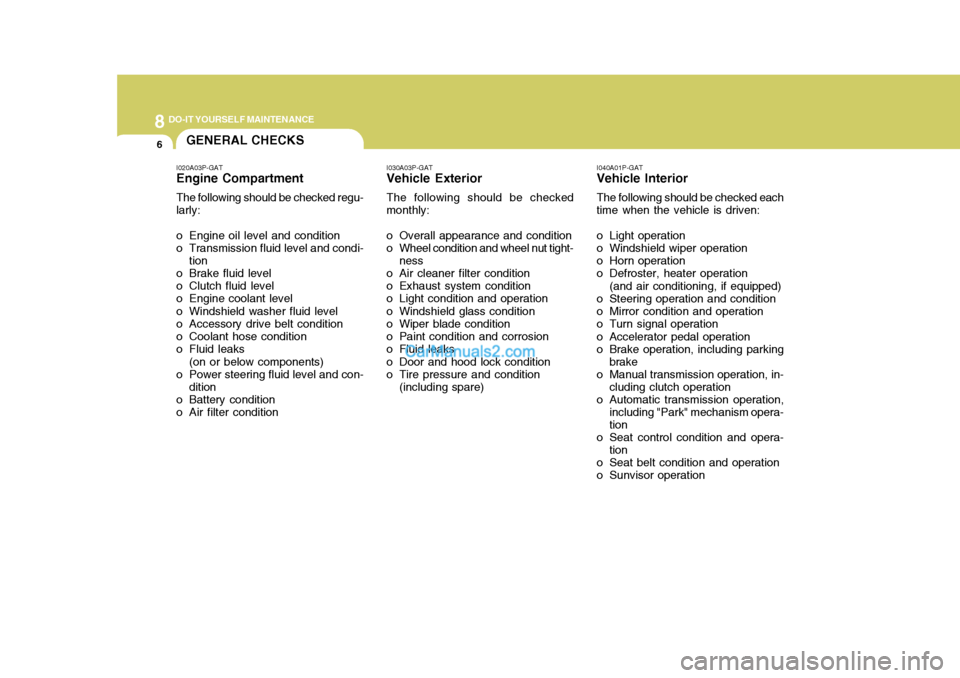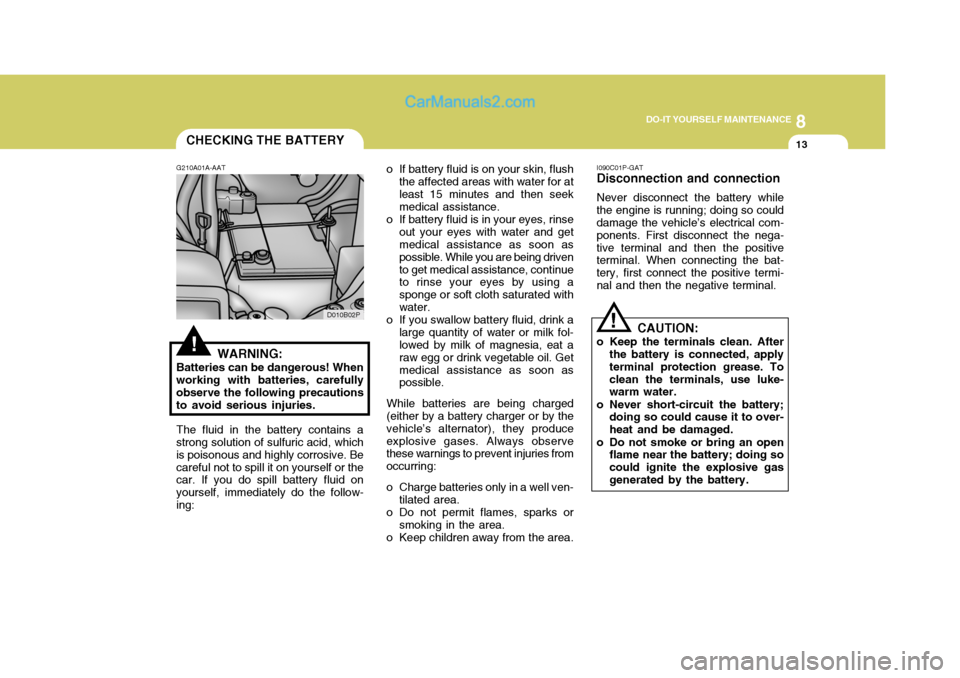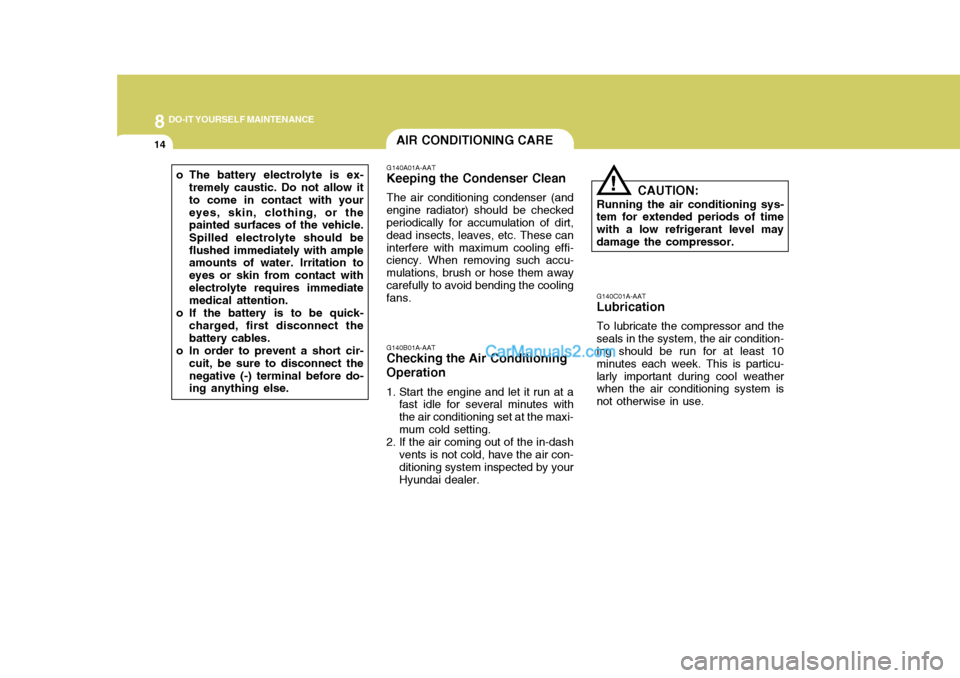Page 175 of 205

8DO-IT YOURSELF MAINTENANCE
6GENERAL CHECKS
I020A03P-GAT Engine Compartment The following should be checked regu- larly:
o Engine oil level and condition
o Transmission fluid level and condi- tion
o Brake fluid level
o Clutch fluid level
o Engine coolant level
o Windshield washer fluid level
o Accessory drive belt condition
o Coolant hose condition
o Fluid leaks
(on or below components)
o Power steering fluid level and con-
dition
o Battery condition
o Air filter condition I030A03P-GAT Vehicle Exterior The following should be checked monthly:
o Overall appearance and condition
o Wheel condition and wheel nut tight-
ness
o Air cleaner filter condition
o Exhaust system condition
o Light condition and operation
o Windshield glass condition
o Wiper blade condition
o Paint condition and corrosion
o Fluid leaks
o Door and hood lock condition
o Tire pressure and condition
(including spare) I040A01P-GAT Vehicle Interior The following should be checked each time when the vehicle is driven:
o Light operation
o Windshield wiper operation
o Horn operation
o Defroster, heater operation
(and air conditioning, if equipped)
o Steering operation and condition
o Mirror condition and operation
o Turn signal operation
o Accelerator pedal operation
o Brake operation, including parking brake
o Manual transmission operation, in-
cluding clutch operation
o Automatic transmission operation,
including "Park" mechanism opera-tion
o Seat control condition and opera-
tion
o Seat belt condition and operation
o Sunvisor operation
Page 182 of 205

8
DO-IT YOURSELF MAINTENANCE
13
D010B02P
CHECKING THE BATTERY
!
G210A01A-AAT
WARNING:
Batteries can be dangerous! When working with batteries, carefully observe the following precautionsto avoid serious injuries. The fluid in the battery contains a
strong solution of sulfuric acid, which is poisonous and highly corrosive. Becareful not to spill it on yourself or the car. If you do spill battery fluid on yourself, immediately do the follow-ing: o If battery fluid is on your skin, flush
the affected areas with water for atleast 15 minutes and then seek medical assistance.
o If battery fluid is in your eyes, rinse out your eyes with water and getmedical assistance as soon as possible. While you are being drivento get medical assistance, continue to rinse your eyes by using a sponge or soft cloth saturated withwater.
o If you swallow battery fluid, drink a large quantity of water or milk fol- lowed by milk of magnesia, eat a raw egg or drink vegetable oil. Getmedical assistance as soon as possible.
While batteries are being charged(either by a battery charger or by the vehicle’s alternator), they produceexplosive gases. Always observe these warnings to prevent injuries from occurring:
o Charge batteries only in a well ven- tilated area.
o Do not permit flames, sparks or smoking in the area.
o Keep children away from the area. I090C01P-GAT Disconnection and connection Never disconnect the battery while the engine is running; doing so could damage the vehicle’s electrical com- ponents. First disconnect the nega-tive terminal and then the positive terminal. When connecting the bat- tery, first connect the positive termi-nal and then the negative terminal.
CAUTION:
o Keep the terminals clean. After the battery is connected, applyterminal protection grease. Toclean the terminals, use luke- warm water.
o Never short-circuit the battery; doing so could cause it to over- heat and be damaged.
o Do not smoke or bring an open flame near the battery; doing socould ignite the explosive gasgenerated by the battery.
!
Page 183 of 205

8DO-IT YOURSELF MAINTENANCE
14
o The battery electrolyte is ex-tremely caustic. Do not allow it to come in contact with youreyes, skin, clothing, or the painted surfaces of the vehicle. Spilled electrolyte should be flushed immediately with ample amounts of water. Irritation to eyes or skin from contact withelectrolyte requires immediate medical attention.
o If the battery is to be quick- charged, first disconnect the battery cables.
o In order to prevent a short cir- cuit, be sure to disconnect thenegative (-) terminal before do- ing anything else.AIR CONDITIONING CARE
G140A01A-AAT Keeping the Condenser Clean The air conditioning condenser (and engine radiator) should be checked periodically for accumulation of dirt, dead insects, leaves, etc. These caninterfere with maximum cooling effi- ciency. When removing such accu- mulations, brush or hose them awaycarefully to avoid bending the cooling fans.
G140B01A-AAT Checking the Air Conditioning Operation
1. Start the engine and let it run at a fast idle for several minutes with the air conditioning set at the maxi-mum cold setting.
2. If the air coming out of the in-dash
vents is not cold, have the air con-ditioning system inspected by your Hyundai dealer. G140C01A-AAT Lubrication To lubricate the compressor and the seals in the system, the air condition- ing should be run for at least 10 minutes each week. This is particu-larly important during cool weather when the air conditioning system is not otherwise in use.CAUTION:
Running the air conditioning sys- tem for extended periods of time with a low refrigerant level maydamage the compressor.
!
Page 201 of 205

10INDEX
2
A ADJUSTABLE FRONT SEATS ................................1-30
AIR CONDITIONER FILTER ........................... 2-47, 8-15
AIR CONDITIONING CARE .....................................8-14
AIR CONDITIONING SYSTEM ................................2-44
ALTIMETER .............................................................. 2-18
ANTENNA ................................................................. 2-73
ANTI-LOCK BRAKE SYSTEM ................................. 3-23
APPEARANCE CARE ................................................ 5-2
ASHTRAY ................................................................. 2-36
AUDIO FAULT CODE .............................................. 2-70
AUDIO SYSTEM Cassette Tape Player Operation (H240, H280)...................................................................... 2-54, 2-65
Compact Disc Player Operation (H260, H280)
...................................................................... 2-59, 2-67
Stereo Radio Operation (H240, H260, H280) ............................................................ 2-51, 2-56, 2-62
AUTOMATIC TRANSMISSION .................................. 3-9
AUTOMATIC TRANSMISSION FLUID ....................8-17
AUXILIARY SEAT ..................................................... 1-36BBACK WARNING
SYSTEM ..................................... 3-24
BATTERY ................................................................. 8-13
BEFORE STARTING THE ENGINE .......................... 3-2
BI-LEVEL HEATI NG ................................................. 2-42
BLEEDING THE FUEL SYSTEM ............................ 4-21
BRAKE FLUID .......................................................... 8-16
BRAKE PEDAL ......................................................... 3-21
BRAKE SYSTEM ...................................................... 3-19
BULB WATTAGE ...................................................... 4-38
CCARE OF CASSETTE TAPES ................................ 2-72
CARE OF DISC ........................................................ 2-71
CARRYING CHILDREN ............................................ 1-15
CATALYTIC CONVERTER .................. ...................... 7-3
CENTRAL DOOR LOCKS ......... ...............................1-14
CHANGING A FLAT TIRE ......................................... 4-7CHANGING AND REPLACING FUSES ..................4-27
CHECKING THE DRIVE BELTS .............................. 8-22
CHECKING THE FREEPLAY................................... 8-21
CHILD PROTECTION SLIDE DOOR .......................1-15
CHILD RESTRAINT SYSTEM ..................................1-43
CIGARETTE LIGHTER ............................................. 2-27
CLUTCH FLUID ........................................................ 8-17
Page:
< prev 1-8 9-16 17-24